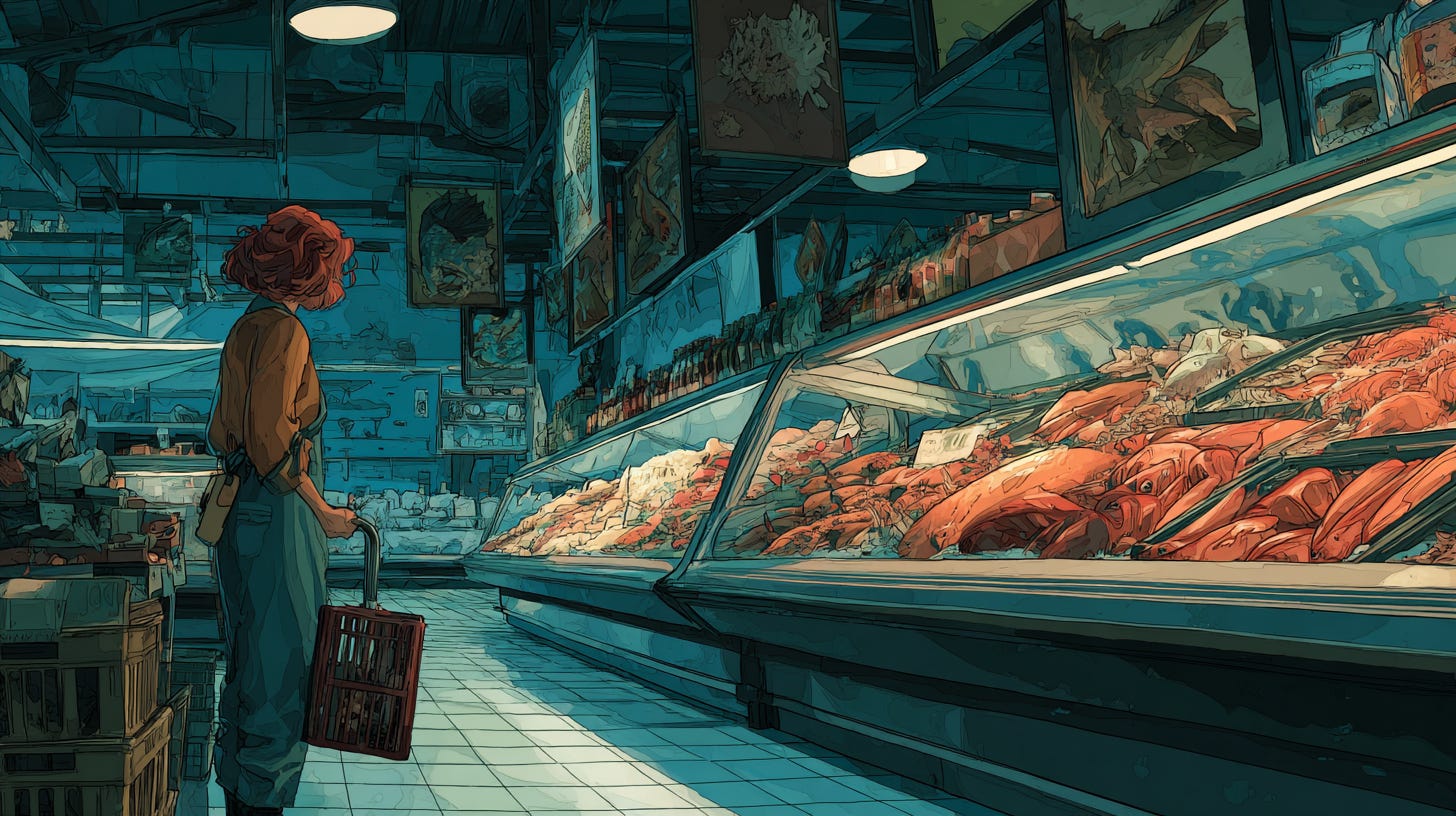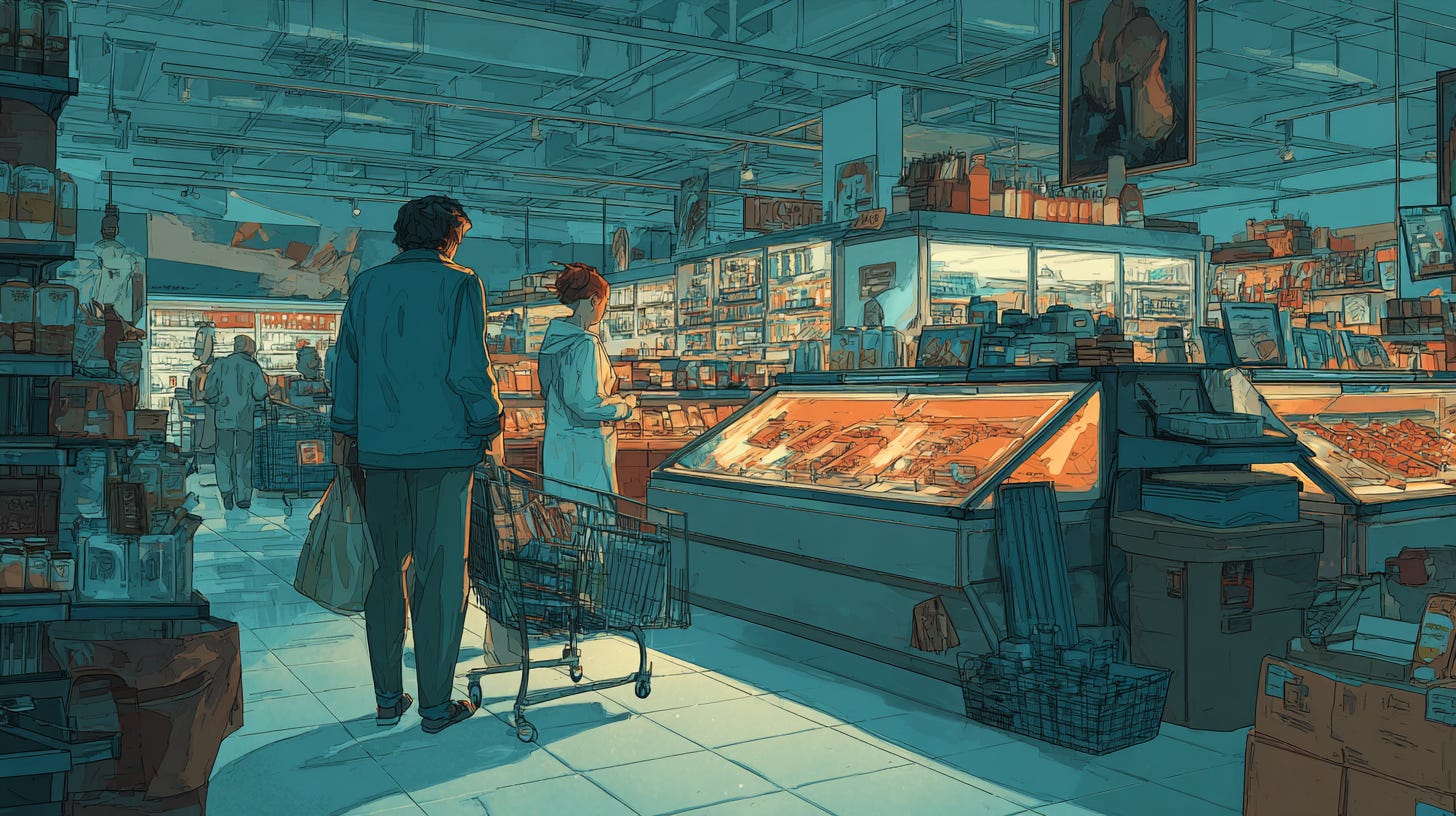For most of us, the food system isn't a distant farm or a produce distribution center. It's the grocery store. We push carts through brightly lit aisles where abstract forces—supply chains, agricultural policy, consumer trends—become tangible reality. The supermarket is where the nation's entire food apparatus converges in a single, accessible arena. The grocery store isn't just a participant in the food system; it is the food system in miniature.
This is where supply meets demand in its most direct form. Every product on the shelf represents a long chain of decisions: a farmer's crop choice, a manufacturer's formulation, a regulator's approval. And every purchase we make sends a ripple back up that chain. For consumers who are generations removed from farming, the grocery store is our most immediate encounter with agriculture itself. To understand the state of our food system, look no further than your local grocer.
What we find there reveals both the system's greatest achievements and its deepest contradictions. The grocery store offers us unprecedented abundance while masking troubling uniformity. It promises choice while concentrating power. It connects us to global supply chains while disconnecting us from the sources of our food. Understanding these contradictions is the key to understanding how our food system really works—and how we might change it.
The Paradox of Abundance
Walk down any aisle in an American supermarket and you'll confront what appears to be infinite variety. Hundreds of cereals crowd the breakfast section. Dozens of yogurt brands compete for refrigerator space. An entire wall of nutrition bars promises everything from weight loss to spiritual enlightenment.
Yet behind this kaleidoscope of branding lies striking uniformity. Those hundred different nutrition bars? Most are built from the same handful of commodity crops—corn, soy, and wheat. The cereal aisle's rainbow of boxes contains variations on the same basic theme. We've created the illusion of choice through brand variety while consolidating actual agricultural diversity into a narrow selection of crops.
This isn't accidental. It's the logical outcome of an agricultural system optimized for scale and efficiency above all else. Corn, soy, and wheat dominate not because they're the most nutritious or delicious, but because they can be grown at massive scale and processed into countless products. The grocery store, in all its apparent abundance, reveals the hidden monotony of American agriculture.
The same consolidation extends beyond ingredients to the stores themselves. While shoppers see thousands of brands, most grocery retail is controlled by a handful of chains. These companies decide which products get premium shelf space, which suppliers get contracts, and ultimately which farmers stay in business. The grocery store that feels like a marketplace is actually a carefully orchestrated system where a few powerful players control most of the outcomes.
Shelf Space Storytelling
In this landscape of managed abundance, brands face a brutal challenge: capturing a shopper's attention in roughly two seconds with a few square inches of package real estate. The front of a package becomes prime territory where complex stories must be reduced to their simplest essence.
This is where nuance dies. A product made with heritage grains grown by a cooperative of small farmers using regenerative practices might simply become "ancient grains" on the front of the pack. The food system's infinite complexity gets flattened into marketing slogans that prioritize emotional appeal over substantive information.
The grocery store environment itself works against deeper understanding. Hurried shoppers navigating fluorescent-lit aisles while juggling shopping lists and crying children aren't in the mood for agricultural education. Those well-intentioned photos of smiling farmers become invisible wallpaper. The little signs explaining sustainable practices can't compete with the thousands of other messages bombarding consumers.
This dynamic warps the entire system. Brands that master simple, powerful messaging thrive regardless of their actual practices. Those that try to communicate complicated truths often struggle to compete. Over time, the market rewards not the best food, but the best marketing. And consumers, hungry for real information but overwhelmed by choice, grab whatever package speaks most clearly to their immediate concerns.
The Geography of Access
The grocery store's role as the food system's public face becomes starkest when we map stores across different communities. In affluent areas, shoppers debate the merits of grass-fed versus grain-fed beef while sipping kombucha from the in-store café. Twenty miles away, families navigate Dollar Generals where the "fresh" section consists of a few bruised bananas by the register, if that.
This geographic apartheid in food access follows predictable patterns that mirror broader inequalities. Wealthy communities get full-service supermarkets with extensive produce sections, in-house nutritionists, and specialty departments. Poor communities get convenience stores and small grocers with limited selection and higher prices. The cruel irony is that those who could most benefit from affordable, nutritious food have the least access to it.
These disparities reveal how our food system distributes power. When some communities get full-service grocery stores while others are left with food deserts, we're seeing the system's priorities made visible. Profit drives location decisions, not nutrition or community need.
Yet alternatives are emerging that point toward different possibilities. Some retailers use profits from wealthy stores to subsidize locations in underserved areas. Mobile markets bring fresh produce directly to food deserts. Community-owned cooperatives keep food dollars circulating locally while ensuring democratic control over food access. These experiments reveal what's possible when we design food distribution around community needs rather than just market logic.
The Collective Action Paradox
Every grocery shopper faces the same psychological trap: "I'm just one person. My choices don't matter." This thinking, perfectly rational at the individual level, becomes problematic when multiplied across millions of shoppers. It's the same psychology that suppresses civic engagement more broadly—one voice rarely changes everything, but when everyone thinks this way, we get the outcomes we deserve by default.
History proves this pessimism wrong. The organic movement started with a handful of "health nuts" shopping at food cooperatives and farmers markets. Today, organic agriculture has transformed farming practices across millions of acres. Fair trade certification, once a niche concern, now influences supply chains for everything from coffee to cotton. These changes didn't happen because any single shopper mattered, but because enough people decided their choices mattered collectively.
The grocery store makes this collective power visible in ways that other civic engagement doesn't. When demand for organic produce increases, stores expand their organic sections within months. When shoppers ask for local products, buyers seek out regional suppliers. When customers demand better working conditions, retailers eventually respond. The feedback loops are faster and more direct than in traditional politics.
This responsiveness is both the grocery store's greatest strength and its greatest weakness as a democratic institution. It can quickly amplify consumer preferences, but it also amplifies inequality. The preferences of wealthy shoppers get heard loudly and clearly, while the needs of poor communities go unmet. Recognizing the grocery store as both mirror and maker of our food system means grappling with this tension.
Practicing Food Citizenship
Grasping the grocery store as the food system's most visible expression changes how we might approach our shopping. Instead of seeing ourselves as individual consumers optimizing for personal benefit, we can think of ourselves as food citizens participating in a collective system.
This starts with diversifying our food sources. Join a CSA for vegetables. Buy meat directly from local farmers. Purchase grains from cooperatives. Keep shopping at your grocery store for everything else. You're not abandoning the mainstream system—you're creating alternatives that keep the entire system more honest and resilient.
Within grocery stores, practice strategic engagement. Ask questions and make requests. Store managers notice when customers inquire about sourcing, suggest new products, or ask why certain items aren't available. Be the person who asks for a bulk section, requests local suppliers, or suggests worker-owned brands. Individual requests might get dismissed, but patterns of customer interest drive purchasing decisions.
Focus your attention where it matters most. Organic certification has the biggest impact on the "dirty dozen" produce items with high pesticide residues. Fair trade certification matters most for products like coffee and chocolate where farmers typically receive tiny portions of retail prices. Local sourcing matters most for products that travel long distances and spoil quickly. Know where your choices make the biggest difference.
Support policy changes that address the grocery store's limitations. Back ordinances that incentivize grocery stores in underserved areas. Support policies that make healthy food more affordable. Champion regulations that require clearer labeling about production practices. The market alone won't fix systemic problems—we need public policies that can address market failures.
The Mirror and the Maker
The grocery store will never be perfect. It will always reflect compromises between efficiency and equity, convenience and sustainability, profit and purpose. But that's exactly why it matters. The grocery store is both mirror and maker of our food system—it reflects our current priorities while shaping our future possibilities.
Unlike far off farms or corporate boardrooms, grocery stores are where we actually encounter the food system in our daily lives. They're where abstract agricultural policies become concrete realities. They're where supply chain decisions show up as empty shelves or abundant displays. They're where our collective choices about what we value get tallied and sent back up the chain.
Recognizing the grocery store as the food system means taking responsibility for what we see there. The abundance and the inequality. The convenience and the hidden costs. The choices and the illusions. These aren't just market outcomes—they're collective creations that we sustain every time we shop.
We are not just shoppers navigating retail spaces. We are participants in a food system that we help create with every purchase. The grocery store is where that participation happens, where our individual choices become collective outcomes, where the future of food takes shape. Understanding this is the first step toward building the food system we actually want.
—
This essay was inspired by my recent podcast episode "The Future of Grocery" on The Tomorrow Today Show.
I was joined by guest co-host Melanie Bartelme from Mintel, and we spoke with Doug Scholz from the California Grocers Association, Cameron Gould Saltman (ex-TikTok Food & Beverage), Michael Robinov from Farm to People, and Errol Schweizer from The Checkout Grocery Update.
You can listen to the full conversation below.












Best article on Groceries in a while. Have you read Austin Fredrick’s Barons? Talks a lot about how Walmart is shifting choice among grocery stores. One player can have a disproportionate role in dictating what farmers grow and the choices that consumers receive. I love your suggestions of how people can vote with their wallets. Thanks for sharing.
What a great morning read - thanks for presenting this complicated topic in a way that reminds us all that change starts right here with our own habits.